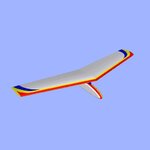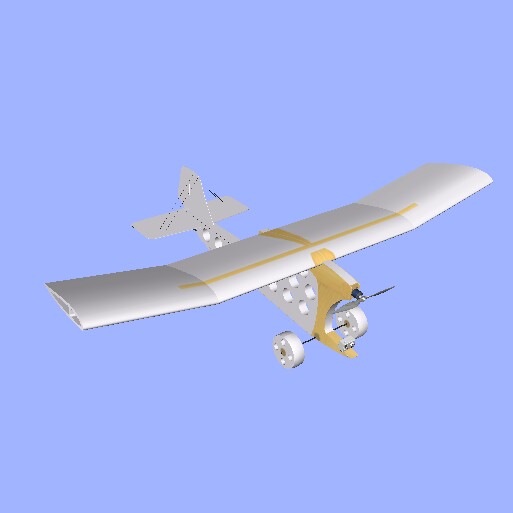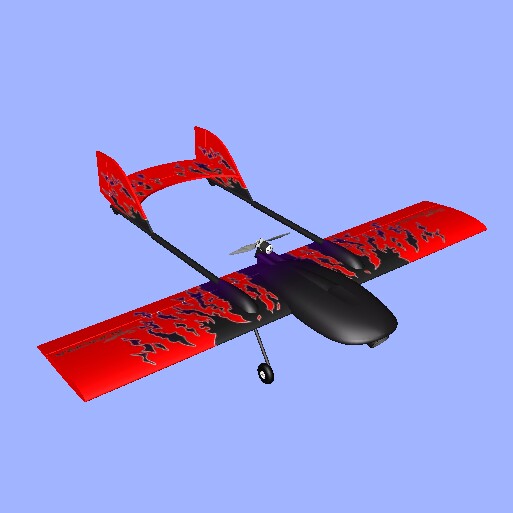Aerial Photography Wing ( with brakes )
This model was designed and built (unfortunately the first design flew only a fraction of a second!) to explore the benefits of a low CG setup on a flying wing.
According to several sources, a low CG on a flying wing will compensate some of the pitching moment of a “normal” profile of a wing. As a “normal” profile will generate more lift, aprox 35% more than a reflex profile, this was a big carrot for us!
Another expected benefit was increased roll stability.
So , the first stage of this adventure was a real model that due to a design flaw, ( thrust line way above the CG), instantly crashed after hand launch. Of course, first reaction was to pick up the pieces, glue them back and try again. By the third attempt the model was destroyed beyond repair. This was frustrating and almost killed the desire to continue.
This unfortunate event led us to a new approach: Difficult model ? OK, a Real Flight plane won’t need any glue after a crash, and will let you play with all the essential characteristics ( profile, CG position, motor position, wing loading, dihedral, washout, etc…), until you get it where you want . Or learn that you cannot get there with what you have !
It took several stages of refinements to get to this final model. It flies well, but as we discovered along the way, there are some minuses coming along with the use of a low CG on a flying wing :
A) The possibility to fly with a “normal” profile, is only partially working. You still need to trim the ailevons up, (give some reflex to the profile) and the end result is a rough flight, with high sinking rate. Give it a try: use Clark Y instead of NACA 23016 and see for yourself what happens. Our conclusion: no real benefit here!
B) Roll stability is indeed increased in straight flight. What is somehow offsetting this, is a bad behavior in turns. Seems like the low body has difficulties following the wing while taking a turn. This is not happening all the time and we are still debating what is really going on over there.
C) Something that we did not anticipate and was a pleasant surprise on this model: increased pitch stability. It’s just like we have added a pitch gyro. Try jerking the elevator stick and see what happens.
D) Brakes. Modeling them for RF was a challenge but , a rewarding one ! Try modifying their size and working angle. You will be surprised how they affect the landing approach, especially if you add some wind in the scenery.
Our conclusion was that the extra structural complexity needed to lower the CG is not rewording enough. At least for the moment, a real model, based on this experiment will not be built. Maybe some of you guys will find this design useful for a particular purpose and give it a try!
Anyway, we are proud for being able to explore this configuration all the way. Without RF, this project would have been probably doomed after the initial disaster.
Design - model physics - conclusion @bujora
Model - texture - @me
This model was designed and built (unfortunately the first design flew only a fraction of a second!) to explore the benefits of a low CG setup on a flying wing.
According to several sources, a low CG on a flying wing will compensate some of the pitching moment of a “normal” profile of a wing. As a “normal” profile will generate more lift, aprox 35% more than a reflex profile, this was a big carrot for us!
Another expected benefit was increased roll stability.
So , the first stage of this adventure was a real model that due to a design flaw, ( thrust line way above the CG), instantly crashed after hand launch. Of course, first reaction was to pick up the pieces, glue them back and try again. By the third attempt the model was destroyed beyond repair. This was frustrating and almost killed the desire to continue.
This unfortunate event led us to a new approach: Difficult model ? OK, a Real Flight plane won’t need any glue after a crash, and will let you play with all the essential characteristics ( profile, CG position, motor position, wing loading, dihedral, washout, etc…), until you get it where you want . Or learn that you cannot get there with what you have !
It took several stages of refinements to get to this final model. It flies well, but as we discovered along the way, there are some minuses coming along with the use of a low CG on a flying wing :
A) The possibility to fly with a “normal” profile, is only partially working. You still need to trim the ailevons up, (give some reflex to the profile) and the end result is a rough flight, with high sinking rate. Give it a try: use Clark Y instead of NACA 23016 and see for yourself what happens. Our conclusion: no real benefit here!
B) Roll stability is indeed increased in straight flight. What is somehow offsetting this, is a bad behavior in turns. Seems like the low body has difficulties following the wing while taking a turn. This is not happening all the time and we are still debating what is really going on over there.
C) Something that we did not anticipate and was a pleasant surprise on this model: increased pitch stability. It’s just like we have added a pitch gyro. Try jerking the elevator stick and see what happens.
D) Brakes. Modeling them for RF was a challenge but , a rewarding one ! Try modifying their size and working angle. You will be surprised how they affect the landing approach, especially if you add some wind in the scenery.
Our conclusion was that the extra structural complexity needed to lower the CG is not rewording enough. At least for the moment, a real model, based on this experiment will not be built. Maybe some of you guys will find this design useful for a particular purpose and give it a try!
Anyway, we are proud for being able to explore this configuration all the way. Without RF, this project would have been probably doomed after the initial disaster.
Design - model physics - conclusion @bujora
Model - texture - @me






